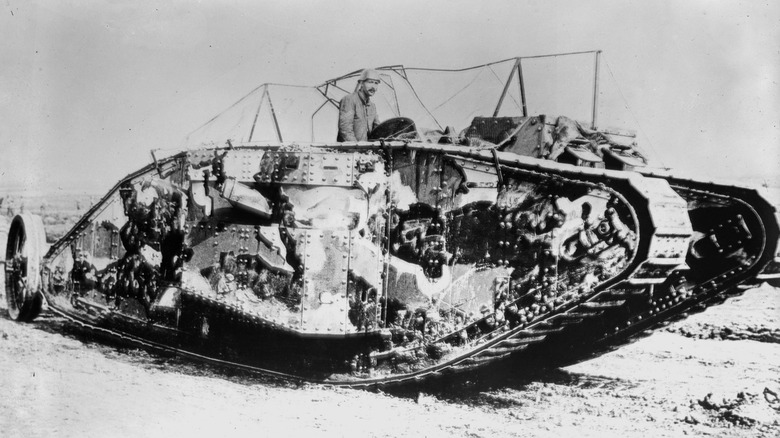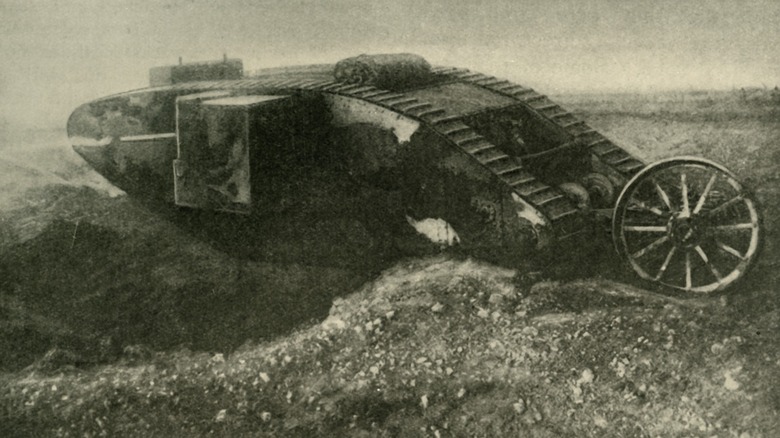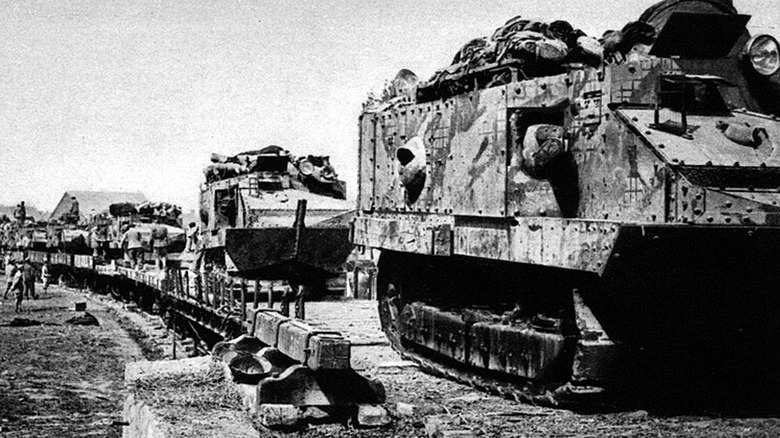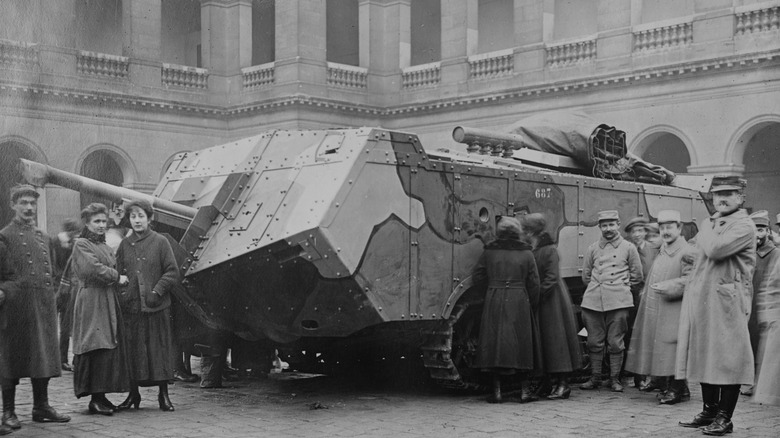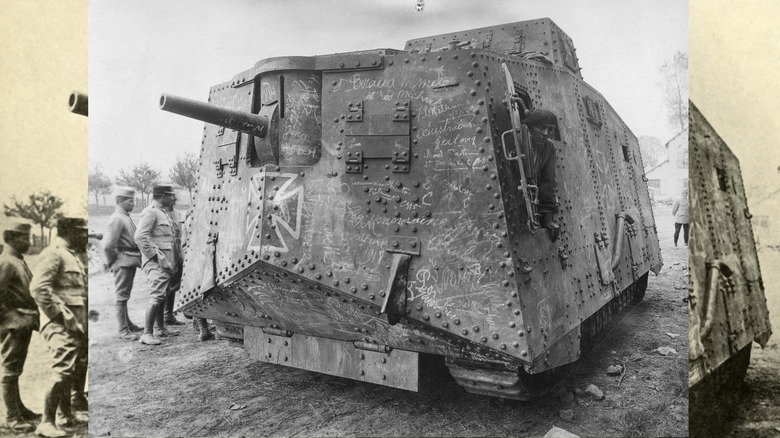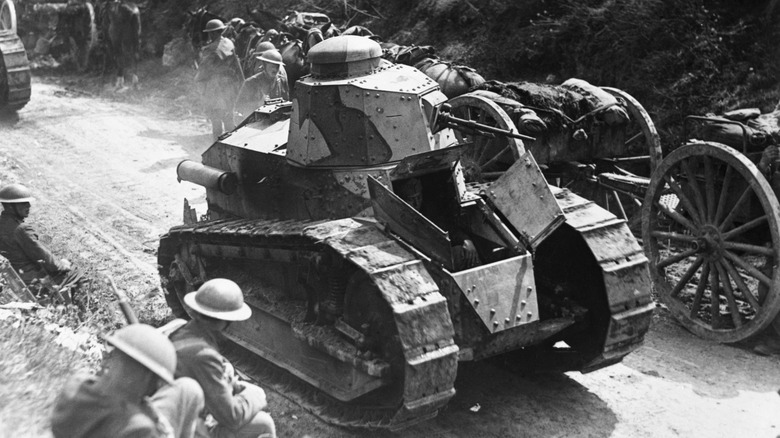5 Of The First Tanks To Ever See Live Combat
Tanks are a staple in modern warfare. From the German Blitzkrieg through Poland and France in the early part of World War II, to the use of modern main battle tanks in the frontlines of Ukraine in 2024, these armored vehicles have faced countless battles throughout the 20th and 21st centuries. However, it hasn't always been this way. For millennia, armies on foot and horseback met on vast open fields until the advancements of the Industrial Revolution mechanized warfare. New technologies, like machine guns, accurate artillery, and long-range rifles, made this type of confrontation unsustainable.
During the first three months of World War I, the French, German, and British armies lost 380,000 men in total — a record number — and by the end of 1914, the dead and wounded exceeded four million men. This massive loss directly led to the introduction of trench warfare on the Western Front, where the front line stabilized across a series of trenches from the Swiss border to the English Channel.
Throughout 1915 and 1916, the Western Front was at a stalemate, with multiple offensives from both sides suffering thousands of casualties, with little to no gains to show for it. The British and the French eventually secretly created armored vehicles to overcome this deadlock. These are the first few tanks to face the test of fire in live combat.
Mark I Tank
The Mark I Tank is the product of the British Landships Committee, which aimed to create an armored vehicle impervious to gunfire and trample over obstacles, including trenches and barbed wires. The first prototype was the "Little Willie," which eventually became "Big Willie" until it finally entered British service as the Mark I.
The Mark I tanks were the first tanks ever to see combat, going into action against the Germans at the Battle of the Somme on September 15, 1916. The British built 150 examples of the Mark I in two variants — 75 female types armed with two Vickers water-cooled heavy machine guns and 75 male types — this time a six-pounder cannon mounted on a sponson on each side. These tanks also had a tail-wheel assembly used for steering, counter-balance, and support when crossing trenches, which isn't found in later versions apparently due to reliability issues.
The British eventually received newer versions of the tank, leading to the Mark II, III, IV, and V. These variants received improved armor, a more powerful engine, and even more machine guns. When these vehicles reached the front lines, the original Mark I tanks were relegated to non-combat duties, including serving as armored supply tanks and wireless signal tanks equipped with a large antenna.
Schneider CA 1
Tanks were still a new concept during World War I, so we didn't have the standard hull and turret design in most modern tanks. The first tank makers experimented with different designs, and the first French tank — the Schneider CA 1 — was based on the American Holt Tractor, which eventually became the Caterpillar Tractor Company.
The CA 1 is basically an armored box placed on an extended Holt chassis. It had one 75 mm Schneider cannon mounted on the front-right corner of the tank, while it also had two 8mm Hotchkiss M1914 machine guns mounted on a ball mount at each side. A 75 horsepower engine drives the tank, giving it a five-mph top speed. The Schneider CA 1 had a crew of six, including the commander, driver, engineer, and three gunners.
Aside from the box-on-chassis design, the CA 1 had a pointed nose to help the driver see, but it also had a track up front and a tail to get through obstacles on the front line, including barbed wires and trenches. This design gave the CA 1 tank the silhouette of a ship, with General Joffre, who ordered 400 examples of this tank, calling them "land ironclads."
However, the CA 1 wasn't very successful in its service. Its first outing on April 16, 1917, was a disaster. Of the 132 tanks deployed that day, only 56 survived the engagement. Many tanks couldn't overcome the obstacles they faced, and their armor wasn't strong enough to stand up to direct fire from German field guns. Most surviving tanks were eventually relegated to training or supply duties, with a select few participating in minor offensives with heavy infantry support.
[Featured Image by Der Weltkrieg im Bild via Wikimedia Commons | Cropped and scaled | Public Domain]
Saint-Chamond
The Saint-Chamond is a cousin to the Schneider CA 1, and both tanks were developed in parallel. Like the latter, the Chamond had a similar box-on-track design, but featured a 75 mm gun front and center of the tank.
In addition, the Saint-Chamond had four machine guns — one on each side — for engaging infantry. However, this tank had a long, overhanging nose — meaning it wasn't a stable platform, and could easily sink into the ground, especially when crossing terrain, obstacles, and trenches.
This heavy tank had its first engagement on May 5, 1917, at Laffaux Mill. However, it was a disastrous opening, with only three tanks able to overcome the obstacles on the field, while the rest got stuck in enemy trenches. They were soon discontinued from use as offensive tanks, but were often effective as mobile assault guns. This made them the precursor of mobile assault guns like the Sturmgeshütz III — one of the most dangerous Axis tanks in the Second World War.
Sturmpanzerwagen A7V
Although the Triple Entente believed in the viability of armored warfare, the Germans generally saw them as slow, unreliable beasts that could be defeated by artillery fire or with armor-piercing bullets. Nevertheless, the shock of seeing an armored box that can't be taken down by machine gun fire led them to build a tank of their own.
Daimler-Motoren-Gesellschaft, the precursor of one of the oldest car brands, produced the first prototype — the Sturmpanzerwagen A7V — in 1917 at the behest of the German War Ministry's 7 Abteilung, Verkehrswesen (Department 7, Transport). This tank, literally named "Assault Armored Vehicle Department 7 Transport," was armed with one 57 mm field gun and six Maxim MG08 machine guns — two on each side, and two more at its rear.
Its guns needed two operators each, equal to 14 personnel. It also had a driver, mechanic, signaler, and commander; requiring 18 troops to operate. It also had a lot of ammunition on board, bringing it to over 30 tons. Despite using two 100 horsepower Daimler engines to drive all its weight, the A7V had a maximum speed of 3 mph off-road and could only travel 37 miles — even with 132 gallons of petrol.
Germany ordered 100 A7Vs in October 1917, and 20 were delivered soon after. The A7V first saw action on March 21, 1918, near St. Quentin, France, when five A7Vs started advancing towards British lines. During the assault, three tanks were disabled — either due to a mechanical breakdown or by getting stuck in obstacles. Nevertheless, the two remaining A7Vs pressed on and successfully captured their objectives.
Despite its successful combat debut, the A7Vs failed to succeed in the Second Battle of Villers-Bretonneux on April 24, 1918. This event led to the tank's removal from service and the cancellation of its remaining order.
Renault FT
This tank isn't the first one the French made, but it had the longest-lasting impact, and is one of the military vehicles that changed the course of history. That's because the Renault FT is considered the first modern tank, featuring a hull and turret you can still find in most modern tanks today.
Unlike the previous designs, which were slow, lumbering beasts, the Renault FT is a compact, agile tank that ruled World War I battlefields. It was powered by a 4.5-liter four-cylinder engine outputting 39 horsepower. However, it only weighed seven tons, and only had a crew of two — the driver and the gunner/commander. It was also armed with a 7.92 mm Hotchkiss machine gun, or a Puteaux SA 18 37 mm short-barreled cannon.
The FT's first operation was on May 31, 1918, when 31 tanks of the 501st Regiment d'Artillery Speciale repelled a German advance at Ploissy-Chazelle. This single tank regiment defeated two German divisions while only suffering five losses. This showed the tank's potential, and many countries, including the U.S., ordered or licensed it for their use.
